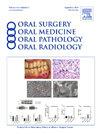Venolymphatic malformation in the buccal space: magnetic resonance imaging features
IF 2
3区 医学
Q2 DENTISTRY, ORAL SURGERY & MEDICINE
Oral Surgery Oral Medicine Oral Pathology Oral Radiology
Pub Date : 2025-02-04
DOI:10.1016/j.oooo.2024.11.044
引用次数: 0
Abstract
Clinical Presentation
Venolymphatic malformation in the buccal space is relatively rare. A 27-year-old male with a soft, compressible mass in the right posterior maxilla causing facial asymmetry and gingival bleeding underwent pre- and post-contrast magnetic resonance imaging (MRI), revealing a heterogeneous but predominantly cystic lesion involving the right buccal space, extending superficially as also deeply to involve the buccinator and the anterior masseter, and inferiorly to the buccal space and inferolateral aspect of the right pterygomaxillary fissure. No osteolysis was identified. Slightly increased signal on T1 is noted from proteinaceous material or blood products as some areas show fluid levels. It is more conspicuous on the contrast-enhanced T1-weighted images with fat suppression. It appears to have primarily high T2 signal. There are focal areas of decreased T1 and T2 signal that are non-enhancing and may represent calcified phleboliths. No evidence of dilated vascular structures is identified suggesting a high-flow lesion.
Differential Diagnosis
Includes capillary, venous, lymphatic, and arteriovenous vascular lesions, hemangioma. For phleboliths: calcified lymph nodes, atherosclerosis, sialoliths, cysticercosis, miliary skin osteomas etc.
Diagnosis and Management
The diagnosis was confirmed via clinical evaluation, MRI, and aspiration. Findings were consistent with a low-flow, venolymphatic malformation involving the right buccal space and right pterygomaxillary fissure. The lesion was embolized and resected.
Conclusion
Although diagnosis of most cases of venolymphatic malformation may not be difficult, it can be challenging if superimposed with trauma, hemorrhage, or infection. Risk of severe hemorrhage exists if extraction in the region is performed. Dynamic contrast-enhanced MRI has greater specificity of diagnosis in that it can differentiate between low-and high-flow lesions. Management of vascular malformations is based on the lesion's vascular anatomy, anatomical location, and involvement with surrounding structures. Non-invasive intervention includes endovascular embolization, sclerotherapy and laser therapy.
求助全文
约1分钟内获得全文
求助全文
来源期刊

Oral Surgery Oral Medicine Oral Pathology Oral Radiology
DENTISTRY, ORAL SURGERY & MEDICINE-
CiteScore
3.80
自引率
6.90%
发文量
1217
审稿时长
2-4 weeks
期刊介绍:
Oral Surgery, Oral Medicine, Oral Pathology and Oral Radiology is required reading for anyone in the fields of oral surgery, oral medicine, oral pathology, oral radiology or advanced general practice dentistry. It is the only major dental journal that provides a practical and complete overview of the medical and surgical techniques of dental practice in four areas. Topics covered include such current issues as dental implants, treatment of HIV-infected patients, and evaluation and treatment of TMJ disorders. The official publication for nine societies, the Journal is recommended for initial purchase in the Brandon Hill study, Selected List of Books and Journals for the Small Medical Library.
 求助内容:
求助内容: 应助结果提醒方式:
应助结果提醒方式:


